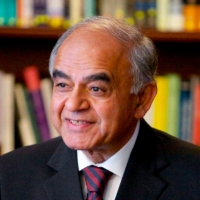India — Skipping the Industrial Revolution?
Can India advance to the IT age without first undergoing an industrial revolution?
November 18, 2001
The most direct answer to such fears is that the value added in the new Information, Communication and Entertainment (ICE) economy is far higher than in the old economy.
Put another way, a little bit of Indian software will be able to buy a great deal of a generic commodity like steel.
In the globalized open economy governed by the World Trade Organization, we will make only what we are good at. That means goods and services where we have a comparative and competitive advantage — and we will import the rest.
Fortunately, we Indians are competitive in many areas. We will, for example, make aluminum, cement and pharmaceuticals — but we will import steel and fertilizers. We are also low-cost producers of at least 12 agricultural commodities.
Once we reform our agriculture and the world opens its agricultural markets, we should be able to rapidly gain significant world market share in this field.
It is also worth remembering that the new economy is largely a service economy — and creates many more jobs. Meanwhile, the old economy is increasingly cutting jobs, downsizing, mechanizing — and becoming even more capital-intensive.
India, with its vast intellectual capital — two million low-cost English-speaking college graduates each year — is in an excellent position to provide “knowledge workers” to the global economy and to benefit from the knowledge revolution.
With competitive advantages in agriculture and the new knowledge economy, it may in the end be all right for India to skip much of the industrial revolution.
And yet, keen observers of modern India have this grave worry: If our bureaucrats and politicians killed our industrial revolution, won’t they do the same with the knowledge revolution?
I believe they will not prevail this time around, for several reasons. One, because our current economic reforms are curtailing their ability to inflict damage.
Two, because high-technology business is virtual — and it is difficult to control what you cannot see. Three, because the Internet creates transparency and brings transactions into the public domain.
It undercuts the bureaucrat’s power, which is based on the bartering of knowledge.
Many are rightly skeptical about the new economy’s ability to spread to the masses. They can only see the “digital divide.” It is true that people will benefit only if they have education.
It is also true that four out of ten children in India are illiterate. It is worse for girls and in the northern states, where teachers are often absent and schools lack even the basic facilities. Children are not motivated to learn and drop out.
But there is a hopeful sign. There is a new-found thirst and enormous pressure from below for education. In the past six years, India’s literacy rate has risen from 52% to 62%.
This is a huge improvement. And if this trend continues, universal literacy is not far behind — despite the politicians. The happiest news comes from India’s most underdeveloped states, where growth has accelerated the most.
Among girls, literacy has grown faster than among boys.
These figures come from a smaller sample and will hopefully be confirmed in 2001. In some states, responsibility for education is beginning to shift to elected village councils.
This has brought more accountability. Two provinces — Madhya Pradesh and Andhra Pradesh — are leading the charge. And their citizens have returned the favor by reelecting their political leaders.
So perhaps there is hope. In the end, if there is one thing that could secure our future, it is vigorous attention to building human capabilities.
For 50 years, India has been a political democracy, which has given voice to the lower castes through the ballot box and shown the world how political democracy can translate into social democracy.
It has now become one of the fastest-growing economies in the world. And it wants to disseminate information technology tools to the common people.
The government’s goal of “IT for All by 2008” reflects an understanding that the spread of information technology is an opportunity.
It is an opportunity for all to overcome historical disabilities and compress the time needed to reach comprehensive development goals.
There is a broader significance in all of this.
If India succeeds in its path of liberal market-based democracy — as it has every right to expect — it will shed new light on the future of liberalism in the world.
Adapted from “India Unbound” by Gurcharan Das. Copyright © 2001 by Gurcharan Das. Used by permission of the author.
Read previous
Global Man, Circa 1913
November 17, 2001
